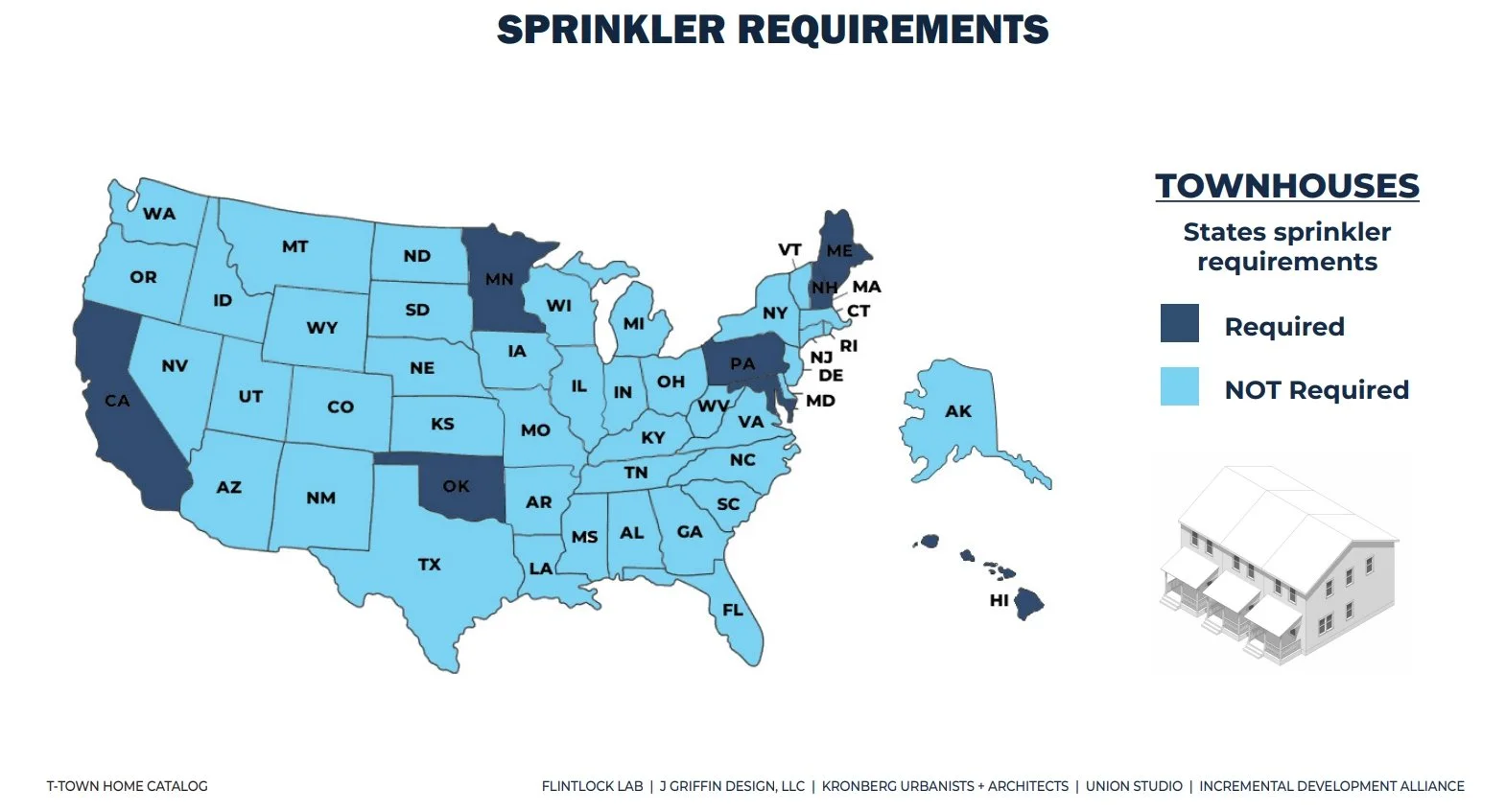Reforming Townhouse Sprinkler Requirements to Unlock Housing in Oklahoma
Oklahoma’s housing shortage demands urgent solutions—and reforming outdated townhouse sprinkler requirements is a critical step. Currently, Oklahoma is one of only eight states that mandates automatic sprinkler systems in all new townhomes, a regulation that significantly raises construction costs—by approximately $10,000 per unit. These costs are ultimately passed on to buyers and renters, making housing less affordable.
Housing Forward is closely examining this requirement. While safety is paramount, any regulation that adds this level of cost must be justified by data-driven analysis —especially when it becomes a barrier to housing access. By modernizing our townhouse regulations, we can expand housing options, support workforce needs, and address our housing shortage—without compromising safety.
Why Townhomes Matter
Townhomes were originally designed for urban elites in 17th-century London but due to rapid urbanization in the late 18th and early 20th centuries their adoption became widespread. As overcrowded worker housing led to public health crises and disease outbreaks, townhomes emerged as a more sanitary and efficient housing solution. They offered housing that could be produced quickly in order to accommodate an influx of workers for new factory jobs and were a safer and cleaner housing option.
Townhomes evolved into practical, space-efficient, workforce housing. In the U.S., they became a staple in older cities like Brooklyn, Baltimore, and Philadelphia—offering an affordable, compact alternative to detached homes.
In Oklahoma, townhomes are rare. They make up just 2.2% of the state’s housing inventory and are mostly found in older neighborhoods. Because Oklahoma’s cities grew much later, our housing stock was built with widespread automobile ownership that allowed households to “drive till you qualify.” Suburbs became a more attractive option for middle-income families that traded townhomes for single-family homes, with lawns and garages.
This scarcity isn’t just due to changing preferences though—it’s also the result of policy barriers like restrictive zoning and costly code requirements, including mandatory sprinklers.
Why Now?
Oklahoma faces a shortage of 85,000 affordable housing units, costing the state an estimated $2.8 billion in lost economic output.[1][2] To meet this demand, we must build more homes—and the right types of homes. According to 2023 census data, 63.5% of Oklahoma households consist of just one or two people. With an aging population and declining birth rates, the need for smaller, more flexible housing options is growing.
Townhomes are ideal for:
Empty nesters looking to downsize
Young professionals seeking walkable neighborhoods
Families who want urban living without the cost of a detached home
They also make efficient use of land. A typical 5,500+ square foot lot can often accommodate duplexes, triplexes, or townhomes, increasing housing supply without increasing sprawl.
How Oklahoma Compares
While some cities across the U.S. require sprinklers in townhomes, Oklahoma is one of only eight states with a statewide mandate. By removing this requirement, we would join 42 other states that have already modernized their approach.
Even without sprinklers, today’s townhomes are built to high safety standards, including a fire separation walls between units, as required by state code.
Benefits of Townhome Development
Neighborhood Activation: Townhomes enhance walkability and vibrancy, especially in areas near jobs and services. They offer attractive, practical designs that fit seamlessly into existing neighborhood – often at a more attractive price point.
Infrastructure Compatibility: In many urban and rural areas, existing water infrastructure cannot support sprinkler systems—making the requirement impractical.
· Code Consistency: Sprinklers are not required for 1- and 2-unit dwellings, even though these buildings often have similar footprints and fire risks as townhomes.[3]
The Bottom Line
Oklahoma’s housing supply must be diverse enough to serve residents at every stage of life and income level. In July, Housing Forward proposed eliminating this sprinkler requirement for new townhomes to the Oklahoma Uniform Building Code Commission (OUBCC), a statewide body that provides oversight for development codes. To keep pace with most states, automatic sprinkler requirements for townhomes should be eliminated with adoption of the 2024 International Residential Code. Eliminating the automatic sprinkler requirement for townhomes would remove a key regulatory barrier and unlock new housing opportunities across the state.
Let’s build a future where every Oklahoman has access to a home that fits their needs and budget.
[1]“Gap Data for Oklahoma.” National Low Income Housing Coalition (2023).
[2] “The State of Housing in America.” U.S. Chamber of Commerce via U.S. Census Bureau (2025).
[3] Griffin Design.

